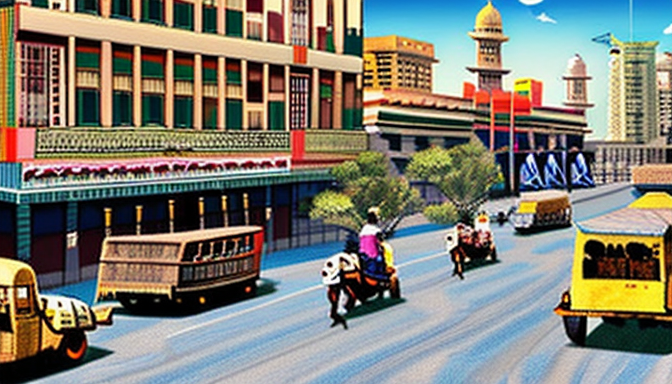Karachi, once a small fishing village, has transformed into one of the largest cities in the world. Can you imagine a time when its shores were just dotted with boats? Today, it’s a bustling metropolis filled with life, culture, and history. This article takes you on a visual journey through vintage photographs and historical maps, showcasing how Karachi has evolved over time.
From its early days, Karachi has been a melting pot of cultures. The influence of various communities can be seen in everything from its architecture to its food. Imagine walking through the streets and smelling the delicious aromas of biryani and karhi, while hearing the sounds of different languages being spoken. Each corner of the city tells a story, reflecting the waves of migration that have shaped its identity.
As we dive deeper into the past, we see how Karachi’s urban landscape has changed dramatically. The once quiet streets have given way to skyscrapers and busy markets. The population explosion has brought challenges, but it has also infused the city with vibrant energy. Historical maps reveal how neighborhoods have expanded and evolved, often reflecting the socio-economic changes of the times.
In this journey, we’ll not only explore the physical changes but also the cultural richness that defines Karachi today. Through photographs, we can witness the blend of old and new, the chaos and charm, and the spirit of a city that continues to thrive against all odds.
Cultural Evolution of Karachi
Karachi is a city that tells a story. It’s a tale woven with threads of diversity and transformation. Once a small fishing village, it has blossomed into one of the largest cities in the world. The cultural evolution of Karachi is nothing short of fascinating. From the bustling streets filled with vibrant markets to the serene coastal views, each corner has a story to tell.
Throughout the decades, Karachi has been a melting pot of cultures. Waves of migration have brought people from all over the country and beyond. Each group has left its unique mark. For instance, the influx of Sindhi, Punjabi, Balochi, and Mohajir communities has enriched the city’s cultural tapestry. This blend is evident in the arts scene, where traditional music, dance, and festivals coexist with contemporary expressions.
Let’s take a moment to appreciate the visual journey that showcases this evolution. Vintage photographs reveal a Karachi that was once dotted with colonial architecture and sandy beaches. Historical maps highlight the city’s expansion, illustrating how it transformed from a quaint harbor into a bustling metropolis. These images serve as a reminder of the city’s dynamic history and cultural richness.
In recent years, Karachi has faced challenges, but it continues to thrive. The arts scene is more vibrant than ever, with galleries and theaters popping up across the city. Local artists are gaining recognition, and traditional crafts are being revived. Karachi is not just a city; it’s a living museum of culture, history, and resilience.

Urban Development and Transformation
Karachi has undergone a remarkable transformation over the years. Once a modest fishing village, it has blossomed into a bustling metropolis. This evolution is not just in size but also in character. Every corner of the city tells a story, a narrative woven through the fabric of time. Have you ever wondered how a city can change so drastically? It’s like watching a caterpillar become a butterfly.
To truly appreciate this journey, one must look at vintage photographs and historical maps. These snapshots capture the essence of Karachi’s past, revealing how its landscape has morphed. From the early days of colonial architecture to the modern skyscrapers that now define its skyline, each image is a window into a different era.
Urban development in Karachi has been a double-edged sword. On one hand, the city has seen significant infrastructure improvements, including:
- Expansion of road networks
- Development of public transport systems
- Creation of new residential and commercial areas
Yet, this rapid growth has not come without challenges. The city faces issues like overcrowding, traffic congestion, and inadequate public services. It’s like trying to fit a square peg into a round hole. The more the city expands, the more it struggles to keep up with the demands of its residents.
In conclusion, Karachi’s urban transformation is a fascinating tale of growth, resilience, and adaptation. It serves as a reminder of how cities evolve, shaped by the people who inhabit them and the challenges they face.
Frequently Asked Questions
- What is the historical significance of Karachi?
Karachi has a rich history that dates back to ancient times. It evolved from a small fishing village into one of the largest cities in the world, influenced by various cultures and civilizations. This transformation reflects the socio-economic changes that have occurred over centuries.
- How has the cultural landscape of Karachi changed?
The cultural evolution of Karachi is a tapestry woven from diverse influences. Migration patterns, historical events, and artistic movements have all played a role in shaping the city’s vibrant arts scene, making it a melting pot of traditions and modernity.
- What are the major urban development challenges faced by Karachi?
As Karachi continues to grow, it faces significant challenges such as inadequate infrastructure, traffic congestion, and housing shortages. These issues are exacerbated by rapid population growth, making urban planning and development crucial for the city’s future.
- How is Karachi’s economy evolving?
Karachi’s economy is dynamic, with a mix of industries including finance, manufacturing, and trade. However, it also struggles with economic disparities, which impact the overall growth and development of the city.